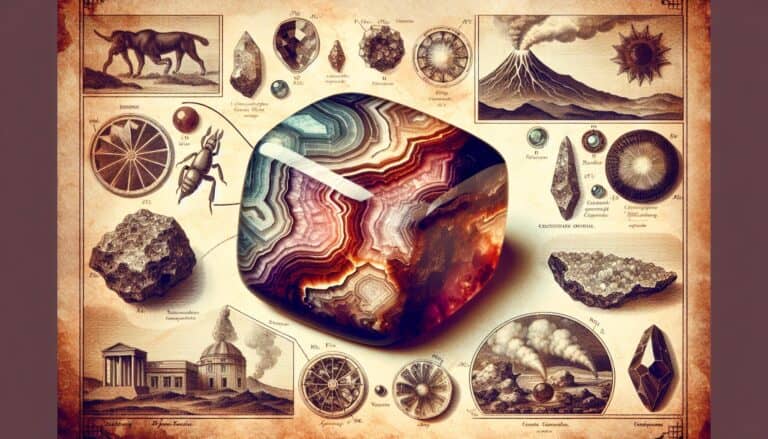Ever wondered about the value of that deep-red gemstone catching your eye from the jeweler’s display?
Garnet, with its rich hues ranging from fiery red to vibrant green, isn’t just another pretty stone. It’s a gem that’s been cherished through the ages, but what’s it really worth?
Determining the worth of garnet isn’t as straightforward as you might think. It’s not just about color; clarity, size, and even the type of garnet all play a role in its value.
Get ready to dive into the sparkling world of garnets and discover what factors make this gemstone a treasure in terms of cost.
Garnet’s value is determined by color, clarity, cut, and rarity. Deep red, especially with purple hues, is most valuable, but rare green Demantoid and Tsavorite can fetch higher prices. High-quality garnets with fewer inclusions and expert cuts are priced higher. Demand, availability, and gemstone trends also affect garnet prices.
What Is Garnet?
When you’re exploring the value of gemstones, understanding what garnet is becomes pivotal. Garnets are a group of silicate minerals that have been used since the Bronze Age as gemstones and abrasives. All species of garnets possess similar physical properties and crystal forms, but differ in chemical composition. That’s where the rich variety of colors comes in—from deep red to vibrant green.
Interestingly, the term “garnet” stems from the Latin word “granatum,” due to its resemblance to the pomegranate seeds. But don’t let the name fool you; garnets are far tougher than their fruity counterpart. They stand at 6.5 to 7.5 on the Mohs scale of mineral hardness, making them durable enough for everyday jewelry wear.
The most common and well-known type of garnet is the pyrope garnet, typically a deep, sultry red. Other varieties include:
- Almandine: A red to brownish-red stone
- Spessartine: Found in shades of orange
- Grossular: Showcasing a spectrum of colors
- Andradite: Including the rare green demantoid garnet
- Uvarovite: Always in the richest shades of green
These varieties not only introduce you to a kaleidoscope of colors but also to the complexities in their value. Each garnet has its own unique properties, with certain types like the demantoid or tsavorite being far more valuable due to their rarity and brilliance.
Knowing what garnet you have on your hands is essential in understanding its worth. Do thorough research, perhaps consult with a gemologist, to ensure you’re fully aware of the garnet’s characteristics. This knowledge helps in appreciating its beauty beyond just the color, and in recognizing the factors that determine its value within the gemstone market.
Garnet Prices: Factors That Affect Value

Understanding how much your garnet is worth entails looking at several factors that influence its value. From color to clarity, and even how the gem is cut, every detail plays a crucial role in determining the price.
Color, Clarity, and Cut Quality
The most striking aspect of garnets is their color. Vibrant hues are often more desirable and can increase the stone’s value significantly. Deep red garnets, especially those with a hint of purple, are typically the most sought after. Rare colors like bright greens or blues can fetch higher prices due to their scarcity. When assessing your garnet’s color, consider:
- Saturation: The intensity of the color
- Hue: The dominant color
- Tone: The lightness or darkness of the color
Next is clarity. Like diamonds, garnets can have inclusions, or small imperfections, inside the stone. The fewer inclusions, the higher the clarity and, subsequently, the greater the value of your garnet. Exceptional clarity in a garnet can boost its price since it allows more light to pass through, enhancing the stone’s brilliance.
Lastly, cut quality can’t be overlooked. A well-cut garnet will exhibit better light reflection and can be worth more than poorly cut stones, regardless of size. Skilled gem cutters can maximize the natural beauty of a garnet by choosing cuts that enhance its luster and color. The most common cuts for garnets are:
- Round
- Oval
- Cushion
- Emerald
Market Demand and Availability
Prices for garnet also fluctuate based on market demand and availability. Garnets that are readily available and mined in large quantities typically cost less. Conversely, rare garnets, like certain varieties of spessartine or tsavorite, command higher prices due to their scarcity.
Market trends play a role, too – as certain colors or types of garnet gain popularity, their prices can increase. Jewelry designers often favor unique garnet colors for new collections, which can also drive up demand and value.
Over the past years, new deposits and sources have affected the market. For instance, discoveries of high-quality garnets in countries like Madagascar have brought new varieties to the market, influencing both availability and interest in garnet gemstones.
When considering the market dynamics, keep in mind:
- New mining locations can introduce more stones to the market, potentially lowering the price.
- The popularity of specific garnet types can wax and wane with fashion trends, affecting value.
- Certain garnets maintain historical significance, adding to their allure and price stability.
As you evaluate your garnet’s worth, remember that the ongoing balance of these factors is what will ultimately define its market value. Keep up with the latest trends and consult with experts to stay informed about your garnet’s potential worth.
Understanding Garnet: A Rare Gem

When you delve into the world of precious stones, you’ll find garnet stands out for its alluring qualities and the rarity that adds to its value. Unlike diamonds that have a set market pricing guideline, garnets are assessed individually, making each stone’s worth as unique as its characteristics.
The Rarity of Garnet
Garnets aren’t rare in the sense that they’re hard to find. In fact, they’re quite prevalent in various parts of the world. What sets a garnet apart, however, is its unique color spectrum and the instances where you discover a truly exceptional gem. Here, rarity refers to the stone’s desirable characteristics, such as vibrant color or exceptional clarity that make it stand out.
- Color: Ranges from deep reds to vibrant greens
- Clarity: Some garnets display stunning transparency
- Size: Larger, high-quality specimens are significantly rarer
The rarer the garnet, the greater its value. For instance, the Tsavorite garnet, a brilliant green variety, is cherished for its rarity and can fetch high prices. Remember, rarity goes beyond mere availability—it’s about finding that one garnet that takes your breath away with its beauty and quality.
Origins and Characteristics
Every garnet has a story that starts with its origin. It’s mined from depths of the earth, primarily in countries like Madagascar, the United States, and India. Each location imparts different qualities to the stones, influencing their chemical compositions and, subsequently, their physical properties.
Characteristics of garnets that affect their worth:
- Geographic origin
- Chemical composition: Variances lead to different colors and qualities
- Hardness: Typically ranges from 6.5 to 7.5 on the Mohs scale
- Reflective characteristics: Some garnets have asterism or a star-like effect
You should also consider their historical significance. Garnets have been used for centuries, valued not just in jewelry making, but also in industrial applications due to their abrasive qualities. The story behind each stone can be as alluring as the gem itself, making origins an integral part of understanding a garnet’s worth.
As you continue to explore the value of garnet, take into account these fascinating details about their rarity and origins. These aspects play a crucial role not only in establishing value but also in appreciating the true allure of this versatile and historic gemstone. Keep in mind that every garnet is a snippet of natural history, a colorful piece of the earth that has been treasured since ancient times.
Garnet Grading and Valuation
The Grading System for Garnet
When you’re trying to figure out a garnet’s worth, it’s crucial to understand the grading system that gemologists use. Garnet valuation is not standardized like diamonds, which have the 4Cs (Cut, Clarity, Color, and Carat). However, color and clarity are pivotal in grading garnets. The most sought-after hue is a vibrant, deep red with no brown tinges. Shades like “raspberry” and “rhodolite” often fetch higher prices in the market.
Garnets are assessed by the purity and saturation of their color, and the presence of any imperfections or inclusions. Another aspect is the quality of the cut. Well-cut garnets display better brilliance and color. Size also impacts value, with larger stones being rare and thus more valuable. Additionally, garnets that exhibit asterism or a color change effect are graded higher due to their uniqueness and rarity.
Certification and Appraisal
For a reliable assessment of your garnet’s value, a gemstone certification from a reputable lab is key. Certification documents provide an impartial evaluation of the gemstone’s qualities. This includes a detailed analysis of its color, clarity, cut, and carat weight – crucial information that affects its overall value.
Additionally, an appraisal from a certified gemologist can provide you with a market value for insurance or resale purposes. Appraisals take into account the current demand for garnets, their historical and geographic significance, and the market standards for grading colored gemstones. Remember that the expertise and reputation of the appraiser can greatly influence the trustworthiness of the evaluation.
When seeking certification and appraisal services, make sure you choose recognized organizations and individuals within the gemological field. Authentic certifications and professional appraisals will not only give you peace of mind but will also enhance the garnet’s credibility and saleability should you decide to part with your precious stone.
Current Market Trends in Garnet Pricing
Understanding the current market trends in garnet pricing can help you make informed decisions when purchasing or investing in these gems. Garnet pricing can fluctuate due to various factors, including demand and rarity.
In recent years, garnets have seen increased demand in both jewelry and industrial applications. This surge is partially due to public interest in alternative gemstones that offer a unique look without the price tag of more traditional stones like diamonds and sapphires. Garnets fit this niche perfectly with their rich color palette and relative affordability.
The market is especially favorable for high-quality examples of rarer garnet varieties such as Tsavorite and Demantoid. These particular types are prized for their exceptional beauty and color, fetching higher prices in the market.
| Garnet Variety | Average Price Per Carat (USD) |
|---|---|
| Almandine | 20-30 |
| Pyrope | 10-50 |
| Spessartine | 40-100 |
| Andradite | 50-200 |
| Grossular | 70-500 |
| Tsavorite | 200-2000 |
| Demantoid | 800-2000+ |
Keep in mind that market trends can vary from region to region. While garnet deposits are found globally, specific types may be more abundant in certain locations, which can affect availability and price. For instance, Tsavorite is primarily mined in Kenya and Tanzania, making it more accessible and possibly more affordable in those regions compared to others.
Bear in mind, too, the impact of treatment methods on pricing. Garnets that have undergone treatments to improve their apparent clarity or color typically sell for less than those that are completely natural. Always inquire about any treatments the stones may have undergone before finalizing a purchase.
Staying abreast of current market trends and factors influencing garnet prices equips you with the knowledge to discern what you should be paying for a garnet. Always carry out due diligence by seeking gems from reputable dealers who provide certification, ensuring you’re paying a fair market value for the quality you receive.
The Most Expensive Garnet
When you’re considering the value of garnets, you’ll find that Demantoid garnets often top the list as the most coveted and expensive variety. Originating primarily from Russia’s Ural Mountains, Demantoid garnets boast a distinctive green hue and a brilliance that rivals diamonds. What’s more, the rarer the garnet, particularly those without any treatments, the higher the price it can command.
The allure of Demantoid garnets isn’t solely their beauty. Their rarity plays a significant role in their valuation. Stones over one carat are scarce, and as the size increases, so does the price exponentially. It’s not uncommon to see high-quality Demantoid garnets fetch upwards of $3,000 per carat. In particular, Demantoid garnets displaying a ‘horsetail’ inclusion pattern, distinctive to this variety, are especially prized among collectors and connoisseurs.
Another noteworthy contender in the priciest garnet category is Tsavorite. These striking gems are known for their vibrant, deep green color which can rival that of fine emeralds. Tsavorite garnets are found in East Africa and have quickly gained popularity since their discovery in the 1960s. Pricing for Tsavorite can easily reach up to $2,000 per carat for top-grade stones.
| Variety | Average Price Range per Carat |
|---|---|
| Demantoid | $800 – $3,000+ |
| Tsavorite | $200 – $2,000 |
Prices vary greatly based on the stone’s size, color, clarity, and origin. Investment in these garnet varieties should be well-considered, as their value persists on an upward trajectory. If you’re seeking to add a garnet to your collection or portfolio, targeting these two types may prove beneficial.
Experts recommend purchasing garnets with a certification from a reputable gemological lab. This certification ensures you’re getting a quality stone that’s worth your investment. Rarity, quality, and certification are key to making an informed decision and getting your hands on a gem that doesn’t just sparkle but also holds its value over time.
Buying Garnet: Tips and Recommendations
Where to Purchase High-Quality Garnet
When you’re in the market for high-quality garnets, it’s crucial to know the most reliable places to make your purchase. Your options generally fall into two camps: reputable online retailers and respected brick-and-mortar jewelry stores.
Online Retailers offer the convenience of shopping from home and often provide a wider selection of garnets to choose from. Before adding anything to your cart, make sure to research the seller’s reputation. Read customer reviews and check ratings, looking for a track record of authenticity and customer satisfaction.
Brick-and-Mortar Stores give you the advantage of viewing the garnet up close and personal. You can assess the gemstone’s color and clarity firsthand, and ask a knowledgeable staff member any questions you might have. However, prices may be higher compared to online due to overhead costs.
Whether you opt for the comfort of online shopping or the tactile experience of a jewelry store, prioritize retailers that specialize in gemstones. They’ll have the expertise and variety you’re after, allowing you to find the perfect garnet.
Ensuring Authenticity and Value
To safeguard your investment in a garnet, here are the key steps you should consider before finalizing your purchase:
- Certification: Always ask for a certificate from a reputable gemological lab, such as the GIA (Gemological Institute of America). This document will confirm the gem’s authenticity and provide details on its grade and characteristics.
- Appraisals: Obtain an independent appraisal, especially for high-value garnets. This appraisal should reflect the current market value and offer greater assurance of your gemstone’s worth.
- Return Policy: A vendor confident in their product will offer a reasonable return policy. This allows you to have the garnet evaluated independently to confirm its value and authenticity.
By being vigilant about where you buy your garnet and ensuring it’s backed by certification and appraisal, you’ll be more likely to acquire a stone that’s both genuine and a good investment. Remember, when it comes to precious gemstones, due diligence pays off in the long run.
Conclusion: Buying & Selling Garnet
You’ve seen that the value of garnet can vary widely, but now you’re equipped with the knowledge to make an informed decision.
Remember, whether you’re browsing online or in a physical store, it’s essential to do your homework. Look for sellers with a strong reputation, and don’t hesitate to verify the authenticity of your garnet. With a certificate of authenticity, an independent appraisal, and a solid return policy, you’ll ensure you’re getting the true worth of your investment.
Trust in your newfound expertise to guide you to the perfect piece that not only meets your aesthetic desires but also holds its value over time.







![Maine Rockhounding Sites in [year]: Find Tourmaline & More](https://observationhobbies.com/wp-content/uploads/2024/01/mlZUKYsOvqRrJjM0_zS5h-768x439.jpg)